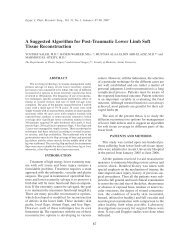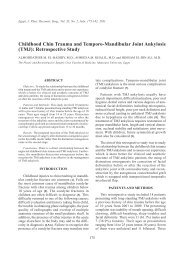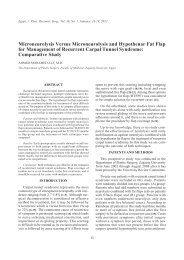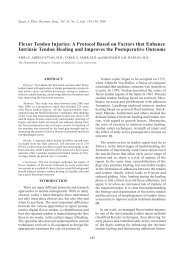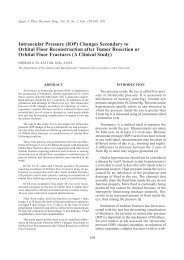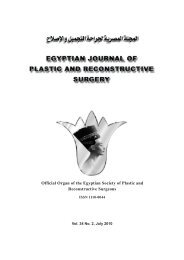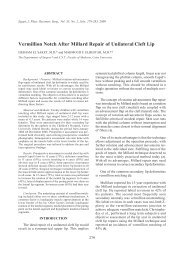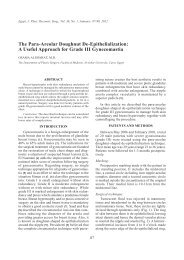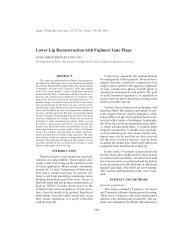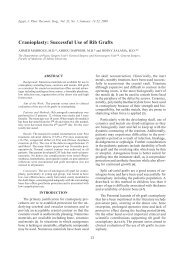A Systemic Approach to Liposculpting the Female Buttocks ... - ESPRS
A Systemic Approach to Liposculpting the Female Buttocks ... - ESPRS
A Systemic Approach to Liposculpting the Female Buttocks ... - ESPRS
Create successful ePaper yourself
Turn your PDF publications into a flip-book with our unique Google optimized e-Paper software.
158 Vol. 29, No. 2 / A <strong>Systemic</strong> <strong>Approach</strong> <strong>to</strong> <strong>Liposculpting</strong> <strong>the</strong> <strong>Female</strong> But<strong>to</strong>cks<br />
These fac<strong>to</strong>rs limit <strong>the</strong> degree of improvement<br />
that can be obtained by liposuction surgery alone<br />
[3].<br />
At <strong>the</strong> present time, patients have various,<br />
different alternatives because of <strong>the</strong> arrival of new<br />
techniques. Undoubtedly, one advance is <strong>the</strong> endermologie,<br />
which is a non-invasive mechanical<br />
method of “aspirated hypodermal mobilization”<br />
that mobilizes superficial adipose layer through a<br />
mo<strong>to</strong>rized rhythmic folding-unfolding and suctionassisted<br />
massage technique that has been advocated<br />
for body con<strong>to</strong>uring and cellulite treatment [4].<br />
Understanding of <strong>the</strong> aes<strong>the</strong>tically pleasing<br />
human form is fundamental. Many authors have<br />
described <strong>the</strong> aes<strong>the</strong>tically pleasing female silhouette.<br />
Viewed from behind, <strong>the</strong> lower <strong>to</strong>rso-upper<br />
thigh area in women is characterized by a gently<br />
undulating double curve with a diminutive fullness<br />
at about <strong>the</strong> level of <strong>the</strong> iliac crest and a larger<br />
swelling at <strong>the</strong> trochanteric area. The hip and thigh<br />
protuberances are separated by <strong>the</strong> gluteal recess.<br />
This normal double curve, glorified by classical<br />
figurative painters, is ana<strong>the</strong>ma <strong>to</strong> women of <strong>the</strong><br />
late Twentieth Century, who seek a slimmer, more<br />
boyish look. These women want ablation of <strong>the</strong><br />
double curve and its replacement by a single smooth<br />
curve with slight convexity when viewed from<br />
behind [1].<br />
The gluteal crease separates <strong>the</strong> posterior upper<br />
thigh from <strong>the</strong> but<strong>to</strong>ck and extends laterally a<br />
variable distance from <strong>the</strong> medial thigh, typically<br />
ending about two-thirds of <strong>the</strong> way <strong>to</strong> <strong>the</strong> lateral<br />
most portion of <strong>the</strong> thigh. Viewed from <strong>the</strong> side,<br />
<strong>the</strong> youthful gluteal mass meets <strong>the</strong> upper thigh at<br />
an obtuse angle and <strong>the</strong> upper but<strong>to</strong>ck projects as<br />
a rounded, subtle fullness slightly more than balance<br />
<strong>the</strong> anterior projection of <strong>the</strong> breasts [5].<br />
Most reports have documented <strong>the</strong> need <strong>to</strong><br />
address <strong>the</strong> hips and trochanteric regions as well<br />
as <strong>the</strong> bulk of <strong>the</strong> but<strong>to</strong>ck. The frame of <strong>the</strong> but<strong>to</strong>ck<br />
consists of <strong>the</strong> hip fat pad, which may merge with<br />
<strong>the</strong> upper outer quadrant of <strong>the</strong> but<strong>to</strong>cks producing<br />
an exaggerated appearance of width and height of<br />
origination; and <strong>the</strong> trochanteric fat pad, which<br />
may merge with <strong>the</strong> inferior outer quadrant of <strong>the</strong><br />
but<strong>to</strong>cks producing an exaggerated appearance of<br />
width in <strong>the</strong> lower but<strong>to</strong>cks [6].<br />
Actually <strong>the</strong>re is a wide range of deformities<br />
affecting <strong>the</strong> hip region in females, and it has been<br />
classified by many authors as Pitman, who described<br />
three general types according <strong>to</strong> <strong>the</strong> amount of fat<br />
and <strong>to</strong>ne of skin [7]. Gasparotti, et al., described<br />
four variations of saddlebag deformities [8].<br />
Grazer and Klingbeil developed an ana<strong>to</strong>mic<br />
classification of female hip and thigh deformities<br />
based on <strong>the</strong> deviation from normal.<br />
Their classification was revised in 1984 <strong>to</strong><br />
conform <strong>to</strong> <strong>the</strong> requirements of liposuction <strong>to</strong> treat<br />
type I through type VII deformities:<br />
Type I : Has excess subcutaneous fat in <strong>the</strong> medial<br />
thighs, often in combination with o<strong>the</strong>r<br />
body deformities.<br />
Type II : Typified by <strong>the</strong> saddle bag trochanteric<br />
bulge, is often seen in ec<strong>to</strong>morphs and<br />
mesomorphs.<br />
Type III: Combine a trochanteric deformity and<br />
an additional bulging of <strong>the</strong> upper hip<br />
or flanks.<br />
Type IV: Is a composite of type II and III, with a<br />
deepened midgluteal depression.<br />
Type V : Is typical endomorphic obesity.<br />
Type VI : Traumatic or congenital deformities.<br />
Type VII: Deformities typify <strong>the</strong> sagging and wrinkling<br />
but<strong>to</strong>cks caused by aging [5].<br />
Although classification is extremely helpful,<br />
<strong>the</strong> surgeon must individualize <strong>the</strong> procedure for<br />
each patient. Numerous techniques have been<br />
described for <strong>the</strong> con<strong>to</strong>uring of but<strong>to</strong>ck, hip and<br />
thigh regions. Especially young plastic surgeons<br />
will be faced with a wide range of liposuction<br />
procedures with a wide range of possible complications.<br />
Also <strong>the</strong>re is a paucity of literature describing<br />
an integrated approach <strong>to</strong> <strong>the</strong> management of<br />
this condition.<br />
On this basis, a practice plan is presented in<br />
this study that addresses <strong>the</strong> majority of concerns,<br />
and eliminates most of <strong>the</strong> fears and provides<br />
consistent reproducible results with a program<br />
incorporating deep and intermediate liposuction,<br />
endermologie and exercise. The aim is <strong>to</strong> optimize<br />
<strong>the</strong> results of but<strong>to</strong>ck, hip and thigh con<strong>to</strong>uring<br />
with blending of <strong>the</strong> adjacent areas and producing<br />
a smooth con<strong>to</strong>ur transition between suctioned<br />
areas while maintaining <strong>the</strong> body’s natural curves,<br />
helped by identifying <strong>the</strong> regions of suction in <strong>the</strong><br />
thigh, but<strong>to</strong>cks and flanks.<br />
PATIENTS AND METHODS<br />
During eighteen months period, from January<br />
2003 <strong>to</strong> June 2004, 20 female patients were operated<br />
on. They ranged in age from 22 <strong>to</strong> 40 years<br />
old (mean, 27 years). All had liposuction performed<br />
in <strong>the</strong> gluteal areas and <strong>the</strong> trochanteric region and<br />
hips, some of <strong>the</strong>m had liposuction performed in<br />
different areas of <strong>the</strong> body <strong>to</strong> improve con<strong>to</strong>ur.




